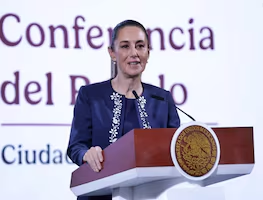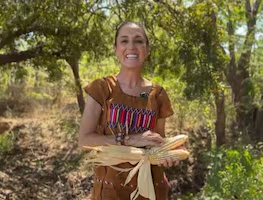Más Información

Claudia Sheinbaum, por definir asistencia presencial a reunión "urgente" de la Celac; migración, tema clave del encuentro

Noroña califica política de EU como hipócrita, racista y fascista; se solidariza con Petro ante deportaciones

Magistrada Mónica Soto propone sustituir al Comité de Evaluación del PJ; plantea someter a insaculación a aspirantes elegibles

Magistrado Reyes Rodríguez propone validar registros de aspirantes con promedio inferior a 8; excluirlos es “estigmatizante”, señala

¿Eres madre trabajadora? Puedes acceder a las guarderías del IMSS; descubre los requisitos y cómo hacerlo
The Tingambato Archeological Site , located in Michoacán, is built over two cities buried four meters deep, according to the latest studies performed by archeologist José Luis Punzo .
The researcher from the National Institute of Anthropology and History (INAH) explained in an interview that Tingambato is an archeological site that was inhabited from year zero to 900 A.D. by locals and that was contemporary to Teotihuacan at some point and continued on the Epicaclassic period (650-900 A.D.).
The latest studies, according to Punzo, have contributed to discover and confirm that there are two previous cities under the one on the surface but that were buried 4 meters deep for some reason.

“On year Zero , there was a first village that was built and on top of it they built another great platform that remained there until 500 A.D. , but it was also covered and on top of it another great city was built, which is the one we can visit nowadays,” he asserts.
However, they still lack information on why those previous cities were built, although he says that they have evidence that suggests that during the third stage people came from what is currently central Mexico near 550 A.D. because they found remains that belong to Teotihuacan .
Recommended: Mexican archeologists uncover pre-Columbian village in Quintana Roo
The Tingambato Archeological site is located between Uruapan and Pátzcuaro in a fertile land full of vegetation and, so far, only some 100 hectares have been studied; nevertheless, exploring the area has not been easy because there are avocado fields in some parts.
Among nature
José Luis Punzo decided to carry out the research at the Tingambato Archeological Site by using LiDAR technology (Light Detection and Ranging or Laser Imaging Detection and Ranging) and drones .
“The research is done with LiDAR technology and drones ; they are expensive, but if we compare it to their results and the time and resources we could need if we didn’t use them, we would realize they are not that expensive,” he asserts.
Tingambato is not widely known, he mentions, however, since 2014 , it has been explored with drones carrying photographic equipment with which they capture air images (orthophotography) that help generate 3D models .
Ortophotographs
contribute to registering pyramids and even in excavation processes. Meanwhile, LiDAR technology “uses a laser pulse to map surfaces. We have built a land LiDAR that provides great precision about the buildings and the architectonic relationships at the site.”
The use of drones and LiDAR is complementary because, on one hand, drones provide information with which a model is created but that presents an issue: the image includes the cover so “drones are very useful in areas without a lot of vegetation. Hence, we have now begun to experiment; we make hybrid models from the images we obtain with drones and the land LiDAR.”
Land LiDAR technology consists of setting a tool over a tripod with several reference sensors . The object rotates 360° and shoots many laser pulses that hit any surface.
Recommended: Evidence suggests Teotihuacan collapsed in 570 A.D.
Moreover, they use air LiDAR that creates a map of the land: “Then, with the help of some algorithms , the vegetation layer is removed, that is how cities are uncovered.”
The city of Tingambato
This archeological site in Michoacán had unique characteristics regarding its production of ceramics and its interaction with nearby places but, according to Punzo, it was definitely one of the most important places in western Mexico .
It all suggests that the city was abandoned near 850 A.D. but the reasons are still unknown. “We know there was a great fire ; there are areas that were completely burnt; we don’t know if there was an internal social problem or an ecological problem. Thanks to geologists and geophysicians that study nearby volcanoes, we know there were volcano eruptions in nearby areas back then but we still don’t have exact data,” he stresses.
Research on the site has been done in collaboration with other national institutions, such as the National Autonomous University of Mexico , and international institutions like the University of Auckland in New Zealand and the University of Strasbourg in France.
The joint work, says the archeologist, has allowed to carry out studies on different materials found in the area. For instance, they found minerals from the southwest of the U.S. and seashells from the Caribbean and the Pacific Ocean.
Recommended: Mexican archeologists recover ancient monolith
Experts have also found three tombs ; the first in 1850, the second in the 1970s , and the third in 2012 .
The discovery of the last tomb was meaningful because it contained the remains of a person with 19,000 beads of green stones, seashells, and human bones. Now, thanks to new studies, José Luis Punzo adds that it was a young woman between 15 and 19 years old. “We are working with the University of Harvard to perform DNA studies. We have discovered that she had a cranial deformity and modified teeth, that is, she belonged to the elite .”
After the results in Tingambato, says Punzo, they want to use the same technologies in over 50 square kilometers in Tzintzuntzan : “It’s a LiDAR research project in collaboration with CONACyT , but due to the COVID-19 health emergency everything is on hold,” says the archeologist.
Recommended: Great Mayan Aquifer: Mexico to digitalize cenotes in Yucatán and Quintana Roo
mp





